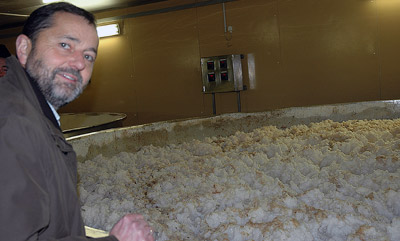In one of its periodic forays into beer, a New York Times tasting panel tackled American-brewed wheat beers, looking primarily for the best “American versions of Bavarian-style brews.”
This can be a bit confusing.
As we expected, the American wheat beers were all over the map, with brewers taking great liberties with the style. This caused no small amount of consternation among the panel, particularly with those beers that styled themselves hefeweizen. Magic Hat Circus Boy, for example, calls itself a hefeweizen, yet it has a floral aroma that is wholly uncharacteristic of the style. Widmer Hefeweizen, which the panel rejected, was another beer that bore little relation to the style.
“You’re trading on the good name of an actual, established style to sell something that’s different,” (panelist Garrett) Oliver said, likening such uses of the term hefeweizen to labeling American white wines as Chablis. “It’s confusing and frustrating.”
As a quick point of order, American Hefeweizen has become pretty well recognized – with its own category at the Great American Beer Festival – as a separate style, with beers from Widmer and Pyramid labeled “hefeweizen” considered benchmarks.
The beer rated tops by the panel was Brooklyn Brewery’s Brooklyner Weisse, where Oliver brews. He’s a frequent participant on these panels and Eric Asimov writes “Mr. Oliver didn’t identify it as his own beer, but was unembarrassed by the panel’s unanimous approval.”
This certainly doesn’t call to question the validity of the results, because the tasting was “blind” and Brooklyner Weisse is an outstanding beer. In-Heat Wheat from Flying Dog in Colorado (a beer that has its own reserved spot in our fridge), Samuel Adams Hefeweizen and Magic Hat Hocus Pocus ranked just a notch lower.
The panel also tasted a few German versions – although they didn’t know that during the blind tasting and those were not rated with the others. One, from Erdinger, did not make the cut, but the other two, from Schneider and Franziskaner, “might well have been our top beers of the tasting.”
Since the discussion here often turns to the importance of tradition in brewing, it is interesting to see that the way brewers of Schneider (G. Schneider & Sohn) and Franziskaner (Spaten, owned by InBev) produce weiss beers has changed.
Schneider leans heavily on tradition – George I founded the brewery in 1872 and according to the company’s website the first words from George VII (born in 1995) were “Schneider Weisse” – and that extends into the brewhouse.
Schneider still employs a decoction mash (where part of the mash is removed, boiled and returned to the original mash), but five years ago Spaten abandoned the traditional method and now uses a single infusion mash. Spaten also uses a lager yeast when bottle conditioning its beers. Schneider uses yeast taken from billowing open fermentation and krausens with speise (unfermented wort) to add the zesty carbonation for which Bavarian weiss beers are known.
Spaten, of course, is much larger, brewing 2.3 million hectoliters (1.2 million of that wheat) a year, compared to 300,000 at Schneider.

“It is a very traditional system, and we are a little bit proud of it,” brewery director Hans-Peter Drexler (pictured beside an open fermenter) said last December while showing off the fermentation room. “We are the only one of this size (meaning as large) still doing these things. It is not easy to keep consistency. Each bottle is its own system.”
Dr. Jörg Lehmann of Spaten explained the decision to use a single infusion mash (which is less time consuming and labor intensive) was made because “the malt quality has improved very much.”
Schneider continues to buy much of its barley from farmers in the region of the brewery and often starts with less modified malt. (You don’t want more brewing science, right? The point here is that barley becomes malt, that less modified malt and decoction often go hand in hand, and that the process is less modern.)
“To me the raw ingredients are very important. I like to go talk to the farmers,” Drexler said. “They are doing the hard work, giving us good materials. The soil is poor and outside in the hills the weather can be hard. Maybe that is good for our malt.”
And, in turn, for the beer.